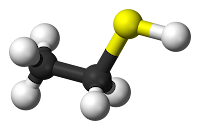Physical properties:
- Hydrogen bonding is much weaker that that in alcohols.
- Lower boiling points that similar alcohols.
- Less soluble in water and other polar solvents than comparable alcohols.
- Low-molecular-weight thiols stink.
- Responsible for smells such as those from rotten eggs and sewage the scent of skunks is due primarily to these two thiols.
Chemical properties:
- 5-Bonds are longer and weaker than those to oxygen.
- 5-H bonds are non-polar covalent since 5 is less electronegative than O.
- No hydrogen bonding.
- Lower boiling points that comparable alcohol.
An example:
IUPAC Name: Ethanethiol
Common Name: Ethylmercaptan


















